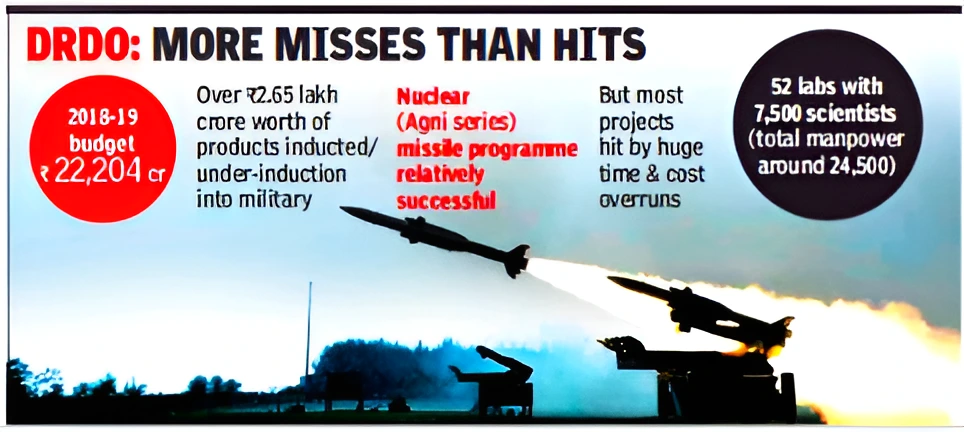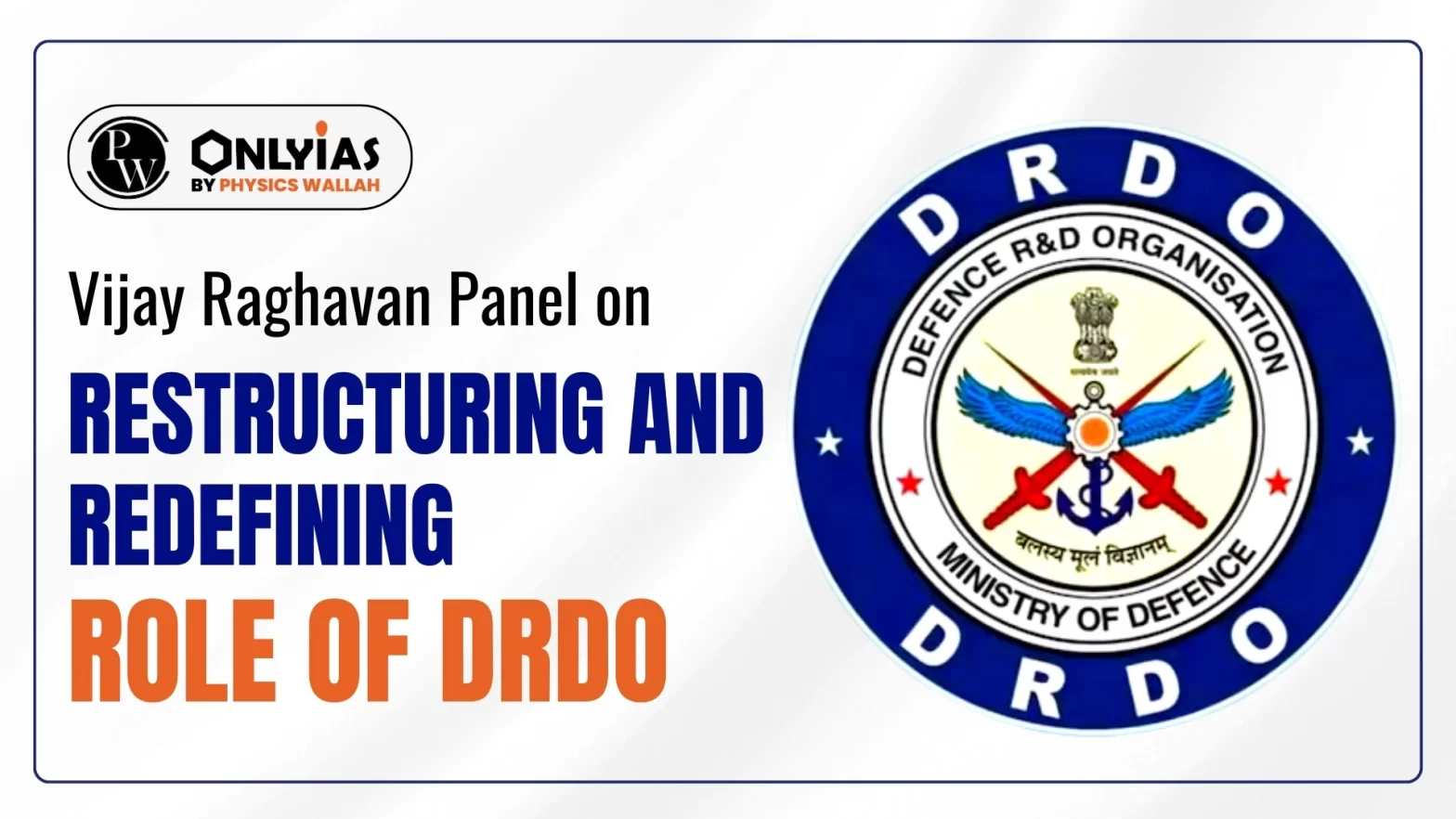Context:
This article is based on the news “Defence upgrade roadmap: Apex body led by Prime Minister, MoD sci-tech unit” which was published in the Indian Express. Recently, the Vijay Raghavan panel has reportedly suggested that a Defence Technology Council (DTC) chaired by the Prime Minister should determine the country’s defence technology roadmap.
| Relevancy for Prelims: Defence Technology Council (DTC), Defence Research and Development Organisation (DRDO), Hindustan Aeronautics Limited (HAL), Agni missile, Prithvi ballistic missile, Akash missile, Trishul missile and Nag Missile.
Relevancy for Mains: Vijay Raghavan Panel for ‘restructuring and redefining’ role of DRDO, Its Key Recommendations. |
Vijay Raghavan Panel and its Key Recommendations
- Vijay Raghavan Panel: The 9-member panel was set up by the government to review the functioning of the Defence Research and Development Organisation (DRDO).
- Reset Focus: According to the sources, the committee has observed that the DRDO should focus on its original Research and Development (R&D) goal for defense.
- Refrain Engagements in Other Tasks: DRDO currently remains engaged in all aspects of its projects, from research to development to production.
- DRDO should refrain from involving itself in productization, production cycles, and product management, which are more suitable for the private sector.
- Establishment of Defence Technology Council (DTC): To determine the country’s defence technology roadmap and decide on major projects and their execution.
- Creation of Department of Defence Science, Technology, and Innovation: The panel has also suggested the creation of a separate department under the Defence Ministry namely the Department of Defence Science, Technology, and Innovation.
About the Defence Technology Council (DTC)
- It is a top body chaired by the Prime Minister, with the Defence Minister and the National Security Advisor as its vice presidents.
- It is proposed to have an executive committee chaired by the Chief of Defence Staff.
- The Principal Scientific Advisor and the three service chiefs and vice chiefs will also be its members.
- Furthermore, it will include representation from academia and industry, with two members from each sector
- It would play a pivotal role in identifying the right players for specific defence technologies.
|
About Department of Defence Science, Technology, and Innovation:
- It will serve as the secretariat for the DTC.
- Proposed to be headed by a technocrat, this department will promote defence research and development in the academic and start-up ecosystem.
- This department will draw scientists from DRDO and academia.
- It will build a repository of knowledge on production expertise.
- It will conduct background research for the DTC, aiding its technology production decisions.
- The department will operate labs for testing and certification, a function also performed by DRDO.
|
About DRDO
- DRDO: It is the R&D wing of the Ministry of Defence, formed in 1958 from the amalgamation of the Technical Development Establishment (TDEs) of the Indian Army and the Directorate of Technical Development & Production (DTDP) with the Defence Science Organisation (DSO).
- Vision: To empower India with cutting-edge defence technologies.
- Mission:
- To achieve self-reliance in critical defence technologies and systems.
- Equipping armed forces with state-of-the-art weapon systems and equipment in accordance with requirements laid down by the three Services.
Significant Achievements of DRDO: Historical, and Recent
-
Historical Achievements of DRDO
-
- Project Devil: To develop short-range surface-to-air missiles (SAM) and intercontinental ballistic missiles (ICBM) in the 1970s.
- Integrated Guided Missile Development Programme (IGMDP): IGMDP between the early 1980s and 2007 for the development of a comprehensive range of missiles, including the Agni missile, Prithvi ballistic missile, Akash missile, Trishul missile and Nag Missile.
- Miscellaneous: DRDO has achieved successes in developing other major systems and critical technologies such as aircraft avionics, UAVs, small arms, artillery systems, etc.
-
Rapid Progress of DRDO
- In March 2023, the Standing Committee on Defence (SCoD) observed that DRDO had made rapid progress with the infusion of private sector involvement in its research-related activities.
- The committee also appreciated the large number of progressive steps taken by DRDO like:
- Setting up of world-class test facilities.
- Signing MoUs with leading industry chambers.
- Transferring technology and patents to the private Industry free of cost.
- Raising the funding under the Defence Technology Development Fund (TDF) from ₹ 10 crore to ₹ 50 crore per project.
Also Refer: List Of Indian Missiles: Complete List, Types And Range
Some of the Major Products Developed by DRDO and Accepted by Armed Forces
- Major Platforms: Light Combat Aircraft Tejas, Remotely Piloted Vehicle Nishant, Pilotless Target Aircraft Lakshya-I, Main Battle Tank Arjun Mk-I, Armoured Amphibious Dozer Mk-I etc.
- Sensors: Airborne Early Warning & Control (AEW&C), Integrated Sonar System for EKM Submarine, Short Range Battle Field Surveillance Radar etc.
- Weapon Systems: Supersonic Cruise Missile ‘BrahMos’, Multi Barrel Rocket Launcher System ‘Pinaka’ Mk-I, Heavy Weight Ship Launched Torpedo ‘Varunastra’ etc.
- Soldier Support Systems: Computerised Pilot Selection System for Indian Air Force, Telemedicine System for Navy, Submarine Escape Suit, Flame Retardant Gloves etc.
Also Refer: Counter Drone System Developed By DRDO |
-
Recent Achievements of DRDO:
-
- Weapon Locating Radar: Nuclear, Biological, and Chemical (NBC) reconnaissance Vehicle and a set of NBC Drugs had been successfully tested after extensive evaluation by competent evaluation teams/bodies.
- Atomic Energy Regulatory Board (AERB) accreditation of the Institute of Nuclear Medicine and Allied Sciences (INMAS) for assessment of personnel radiation exposures.
- Radiation Countermeasures & Biodosimetry Research (Rakshak Project).
- Unmanned Aerial Vehical (Sanjay NETRA).
- Mobile Whole Body Counter (DivyaDrishti).
Major Challenges Faced By DRDO
- Delayed Projects: The government’s decision to review the functioning of DRDO comes against the backdrop of several of its projects suffering from huge delays.
 The Parliamentary Standing Committee on Defence expressed concern in its report presented in December 2023 that out of 55 mission mode projects, 23 could not be completed in time.
The Parliamentary Standing Committee on Defence expressed concern in its report presented in December 2023 that out of 55 mission mode projects, 23 could not be completed in time. - In December 2022, the Comptroller and Auditor General (CAG) report had flagged that 67% of the 178 projects scrutinized by it had failed to adhere to their initially proposed timelines.
- Declining Research Budget: In the past, several DRDO projects were affected by cost overruns, and certain projects were also closed. Further, DRDO’s share of total defence expenditure has also continuously decreased.
- According to Defence Ministry data, the R&D expenditure of the organization has more than doubled since 2010-11, from ₹10,149 crores to the current ₹23,264 crore. However, as a percentage of the total defence expenditure, the spending on R&D has come down from 6.59% to the current 5.38%.
- High Dependence on External Military Platforms: India is still dependent on foreign countries for military platforms, and given the current rate of indigenization, India may achieve 80%-90% of indigenization in the next 10 years.
- The continued dependence on imported weapon systems may further discourage the Make in India initiative.
- As per SIPRI Report, India remained the world’s largest arms importer for the five-year period between 2018-22.
- Working as a Government PSU: The DRDO’s operational model resembles a government Public Sector Undertaking (PSU), which often regards the entire defence process – spanning research, development, and production – as its exclusive jurisdiction.
- Substandard Production: DRDO products frequently do not meet anticipated quality standards, resulting in dismissals by the armed forces.
- Armed forces have rejected 70 per cent of the products in the last 15 years because the products did not meet their standard.
Other Defence Manufacturing Organizations in India:
-
Hindustan Aeronautics Limited (HAL)
-
- It is a Navratna Company, and is the largest Defence PSU under the Department of Defence Production, Ministry of Defence, India.
-
Bharat Electronics Limited (BEL)
-
- BEL, a Navratna Company established in 1954 under MoD has nine Units across India. BEL has core competencies in the Defence sector in areas of Radars & Weapon Systems, Sonars, Communication, EWS, Electro-Optics and Tank.
-
- The Indian Ordnance Factories is the oldest and largest industrial setup forming an integrated base for indigenous production of defense hardware and equipment.
|
Way Forward
- Implement Recommendations of the Vijay Raghavan Panel: The government should actively consider implementing those recommendations by resetting the focus of DRDO on R&D and formally establishing the DTC, etc.
- Address Projects Delayed: Closely monitor and address the issues leading to delays in DRDO projects by streamlining bureaucratic processes, improving project management, and setting realistic timelines.
- The Department of Defence Science, Technology, and Innovation can be important in ensuring timely project delivery.
- Enhance Indigenization Efforts: Encourage indigenous production and innovation to achieve a higher level of self-reliance in defence manufacturing.
- Standing committee on defence has recommended prioritisation on self-reliance.
- Performance Monitoring and Accountability: Implement a robust monitoring and evaluation system to ensure accountability in project execution. Regular reviews by the DTC and relevant parliamentary committees can help track progress and proactively address challenges.
- Public-Private Collaboration: Foster collaboration between DRDO, the Department of Defence Science, Technology, and Innovation, and private companies to leverage diverse expertise and resources.
- The Standing Committee recommended that DRDO tie up with a consortium of industries to create widespread infrastructure to ensure that systems created by DRDO become future-ready.
- Educational and Skill Development Initiatives: The Committee on Defence recommended that DRDO explore collaborating with universities and institutions for its officers to undergo training.
![]() 17 Jan 2024
17 Jan 2024

 The Parliamentary Standing Committee on Defence expressed concern in its report presented in December 2023 that out of 55 mission mode projects, 23 could not be completed in time.
The Parliamentary Standing Committee on Defence expressed concern in its report presented in December 2023 that out of 55 mission mode projects, 23 could not be completed in time. 